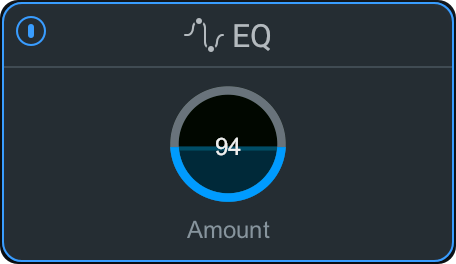EQ
Overview
Use the EQ module to determine the amount of EQ processing that is applied to your audio clip before it is processed by the Reverb module.
Module
The EQ module includes the following controls:

| Control | Description |
|---|---|
| Power Button | Bypasses EQ processing. |
| Amount | Increases or decreases the amount of EQ processing applied to the signal. |
Advanced View
The EQ module advanced view includes an EQ curve view and advanced EQ controls.

EQ Controls
The following EQ controls are available within the advanced view:

Band Controls
You can adjust bands with the following controls:
| Control | Description |
|---|---|
| Band Node | Represents the band and its associated parameters. When a band node is selected, controls related to that band will become available for you to adjust. |
| Power Button | Enables or disables processing of the currently selected band node. |
| Remove | Removes the selected band node. |
Another Method To Remove Bands
Remove nodes by clicking the X (remove button) for that node or by selecting a node and hitting the
delete or backspace key.
Add Bands
You can add up to eight bands using the two methods outlined in the table below.
| Add Band Method | Description |
|---|---|
| Add on the Composite Curve | Hover over the white composite curve and a + button will appear. Click the + button to add a node at that frequency. |
| Add anywhere | Double click anywhere in the EQ view to add a new band node. |
Filter Shape Menu
Select from one of the five filter shapes within the Filter Shape menu to apply to the selected band. The filter shape dropdown menu includes the following the filter shapes:
| Shape | Description |
|---|---|
Bell  |
Smoothly boosts or cuts an adjustable region around a specific frequency. |
Low Shelf/High Shelf  |
Efficient shelf filter for simple boosts or cuts. Similar to the standard shelf in an analog EQ. |
Lowpass/Highpass  |
A filter equipped with a resonance control to emphasize the cutoff frequency with a positive gain. |
Readouts
Use the Readouts in the EQ control bar to see and adjust where the node is located within the EQ. The table below describes the readouts available with each readout’s respective units.
| Readout | Units | Description |
|---|---|---|
| Frequency | Hz | Displays the center frequency (or cutoff frequency) of the currently selected node. The EQ supports frequency values ranging from 20 Hz to 20 kHz. |
| Gain | dB | Displays the amount of gain applied by the selected filter. The EQ supports gain adjustments ranging from -10 dB to +10 dB. |
| Q | (cF/Bandwidth) | Displays the width or slope of the selected filter. |
Adjusting EQ Band Parameters
You can adjust the following EQ band parameters by interacting with the nodes using the adjustments described in the table below.
| Parameter | Adjustments |
|---|---|
| Frequency |
|
| Gain |
|
| Q (Bandwidth) |
|
To manually enter the value for Frequency, Gain, or Q:
- Double click on the value readout of the metric you wish to change.
- Type in the value desired in the text edit field.
- Hit enter or return to save the value adjustment.
TIP: Keyboard Modifiers For Value Adjustments
- Hold the shift key while clicking and dragging the node to lock the movement to the horizontal axis (for frequency) and vertical axis (for gain).
- Hold the shift key while using the arrow keys to make coarse value adjustments.
NOTE: Reset All Band Parameters
You can reset the Gain and Q parameters for a particular band to its default values by double clicking on the node.